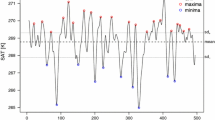Abstract
The linear and quadratic trends of the parameters of interaction of the atmosphere with the ocean in the North Atlantic are computed according to the archival data of the Russian Hydrometeorological Center accumulated for 1957–1990. The linear trends are regarded as probable manifestations of the anthropogenic processes. At the same time, the quadratic trends are regarded as manifestations of natural low-frequency oscillations with a characteristic period of ~65 yr. The linear trends of the sea-surface temperature (SST) and the surface air temperature (SAT) are negative at high latitudes. The thermal (SST-SAT) contrasts and the deficiency of humidity ΔE decrease over the most part of the investigated water area, thus revealing the active influence of the North Atlantic on the trends of SAT caused by the negative feedback in the system supported by the changes in the evident and latent heat fluxes. The significant quadratic trends of various hydrometeorological parameters and total heat fluxes confirm the predominance of natural variability with a period of ~65 yr in the North Atlantic. The quadratic trend of the heat fluxes is mainly caused by the quadratic trend of ΔE. The coincidence of the phases of long-period anomalies of the SAT and ΔE over the major part of the North Atlantic reveals the decisive role of the variability of the ocean in supporting the interdecadal oscillations in the ocean-atmosphere system.
Similar content being viewed by others
REFERENCES
T. S. Delworth and K. W. Dixon, “Implications of the recent trend in the Arctic/North Atlantic Oscillation for the North Atlantic thermohaline circulation,” J. Clim., 13, 3721–3727 (2000).
J. W. Hurrell and H. Loon, “Decadal variations in climate associated with the North Atlantic Oscillation,” Clim. Change, 36, 301–326 (1997).
A. B. Polonsky, E. N. Voskresenskaya, and D. V. Basharin, “Low-frequency variability of the coupled ocean-atmosphere system: Global and regional aspects,” Proc. of the Internat. Conf. on Climate Change and Variability: Past, Present, and Future, Tokyo (2000), pp. 231–236.
A. B. Polonskii and E. N. Voskresenskaya, “On the statistical structure of hydrometeorological fields in the North Atlantic,” Morsk. Gidrofiz. Zh., No. 1, 14–25 (2004).
C. Eden and T. Jung, “North Atlantic interdecadal variability: Oceanic response to the North Atlantic Oscillation (1856–1997),” J. Clim., 14, 676–691 (2001).
V. A. Birman and T. G. Pozdnyakova, “Climatic monitoring of the effective heat fluxes on the ocean surface,” Meteor. Gidrol., No. 4, 102–104 (1992).
S. V. Dmitriev, “On the interpolation of long-term ship data to a uniform grid,” Trudy VNIIGMI-MTsD, 99, 93–98 (1983).
Yu. V. Artamonov, E. N. Voskresenskaya, G. F. Dzhiganshin, et al., Low-Frequency Variability of the Hydrometeorological and Hydrophysical Characteristics of the Tropical and Subtropical Atlantic in Connection with Global Variations of the El-Niño-Southern-Oscillations Type [in Russian], Deposited at VINITI, No. 4560 V-91, VINITI, Moscow (1991).
M. I. Budyko (ed), Atlas of the Heat Balance of the Earth [in Russian], Gosgeoltekhizdat, Leningrad (1963).
A. F. Bunker, “Trends of variables and energy fluxes over the Atlantic Ocean from 1948 to 1972,” Mon. Weather Rev., 108, 720–732 (1980).
A. B. Polonsky and S. I. Kazakov, “On a trend in the coupled system over the North Atlantic and conveyor belt variability,” Proc. of the Regional Workshop on Climate Variability and Climate Change Vulnerability and Adaptation (Prague, Sept. 11–16, 1995), Prague (1995), pp. 54–58.
A. B. Polonskii and E. N. Voskresenskaya, “Low-frequency variability of the meridional drift transport in the North Atlantic,” Meteor. Gidrol., No. 7, 89–99 (1996).
J. W. Hurrell, “Decadal trends in the North Atlantic Oscillation: Regional temperatures and precipitation,” Science, 269, No. 5224, 676–679 (1995).
E. N. Voskresenskaya and A. B. Polonskii, “Trends and interannual variability of the parameters of low-frequency interaction of the atmosphere with the ocean in the North Atlantic,” Meteor. Gidrol., No. 11, 73–80 (1993).
G. R. Bigg, “Comparison of coastal wind and pressure trends over the Tropical Atlantic: 1946–1987,” Int. J. Climatol., 13, 411–421 (1993).
H. Flohn and A. Kapala, “Changes of tropical sea-air interaction processes over a 30-year period,” Nature, 338, No. 6212, 244–246 (1989).
E. N. Voskresenskaya and A. B. Polonskii, “Low-frequency variations of heat fluxes in the North Atlantic,” Meteor. Gidrol., No. 6, 48–58 (1994).
K. E. Trenberth, “Atmospheric moisture residence times and cycling: Implications for rainfall rates and climate change,” Clim. Change, 39, No. 4, 667–694 (1998).
S. Corti, F. Molteni, and T. N. Palmer, “Signature of recent climate change in frequencies of natural atmospheric circulation regimes,” Nature, 398, 799–802 (1999).
D. Cayan, “Interannual variability of moisture and heat fluxes over the North Atlantic,” Euroclivar/US Workshop on the Role of the Atlantic in Climate Variability (Florence, May 11–14, 1998), Workshop Report, Eucliv., Vol. 11 (1998), pp. 22–23.
J. Bjerknes, “Atlantic air-sea interaction,” Adv. Geophys., 10, 1–82 (1964).
Author information
Authors and Affiliations
Additional information
Translated from Morskoi Gidrofizicheskii Zhurnal, No. 4, pp. 19–38, July–August, 2004.
Rights and permissions
About this article
Cite this article
Voskresenskaya, E.N., Polonskii, A.B. Low-frequency variability of hydrometeorological fields and heat fluxes over the North Atlantic. Phys Oceanogr 14, 203–220 (2004). https://doi.org/10.1007/s11110-005-0015-4
Received:
Revised:
Issue Date:
DOI: https://doi.org/10.1007/s11110-005-0015-4




